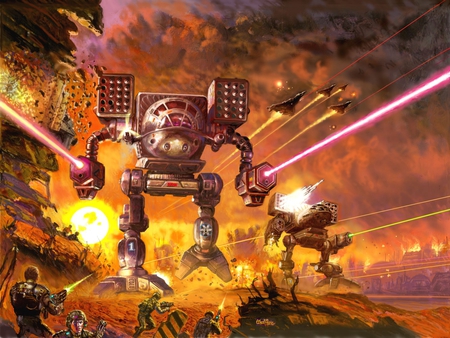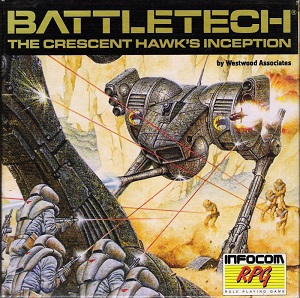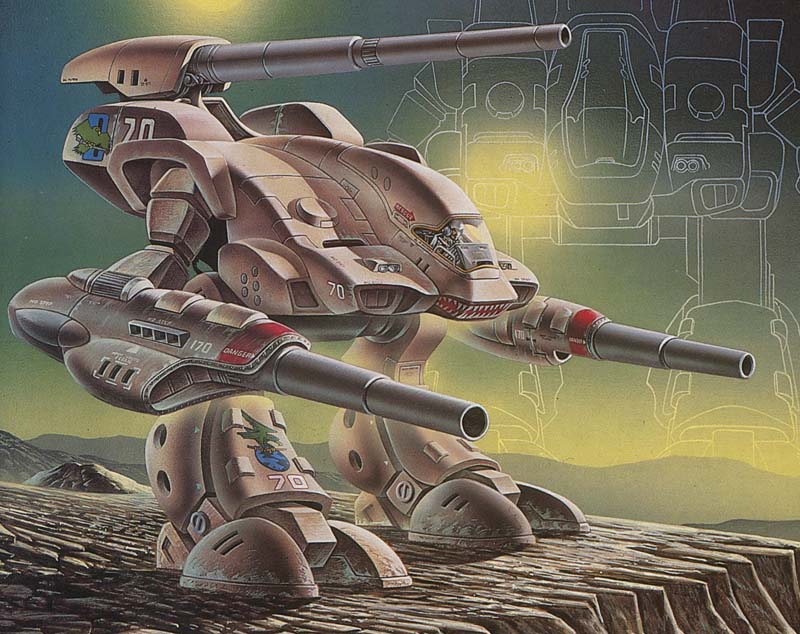Fasa's BattleTech

Immersing myself in the realms of speculative fiction during my formative years, science fiction emerged as a cherished genre—an intellectual refuge not only for me but for many. This predilection coincided with the backdrop of my upbringing in a nation entrenched in scientific ideology, a nation once identified as "Soviet Russia."
In the bygone days, the Soviet government recognized the potency of advancing scientific ideals over more carnal pursuits, a sentiment succinctly summarized by the jest that there is no room for amorous adventures in the Soviet landscape. This strategic decision, a facet of the grand design orchestrated by our communist regime, aimed to position our nation competitively in the unfolding technological and cosmic rivalry between the Eastern and Western blocs.
Many individuals, myself included, who came into existence under the influence of their Soviet progenitors found the transition to the new world order to be an arduous endeavor. On the contrary, some chose the path of non-adaptation, remaining ensconced in their isolated realms, harboring nostalgic visions reminiscent of a bygone era—a phenomenon colloquially referred to as dwelling in their "grandpa delusions."
Yet, those who successfully acclimated themselves to the changing tides unearthed within their very essence an unwavering affection for the realms of science fiction and fantasy. The human brain, a marvel in itself, possesses an extraordinary capability—the power of imagination. It can conjure entire planes of existence, inhabited by sentient energy entities unbound by the need for breathable atmospheres, traversing the cosmic void with sheer cerebral prowess.
The beauty lies in the manifestation of these imaginative realms when individuals endowed with the art of eloquence decide to inscribe their musings and fantastical worlds. These written creations hold the potential to transcend into cult status among enthusiasts, either organically or through the opportunistic endeavors of those captivated by the narratives. Such cultural legacies demand documentation, for there will come a time when humanity extends its reach to the stars, sharing its rich tapestry with cosmic brethren.
Consider the case of George Lucas, who, despite expressing a disdain for the act of crafting Star Wars, undertook the endeavor because of the scarcity of interest in producing a science fiction film. Leveraging the formidable power of his own imagination, the result was not only remarkable but became a mega-successful cultural phenomenon.
So, if the creative impulse compels you to document your thoughts, whether it be a novel, a newly conceived role-playing system, or a vivid vision of a cosmos akin to "Babylon 5," seize the opportunity. You might be the next luminary in the lineage of Arthur C. Clarke or Larry Niven. With this documentary, I pay homage to the splendid science fiction and fantasy universes I have encountered, those yet to be explored, read, played, and even heard, as some music albums boast rich, original storylines and worlds. Let us commence this exploration with the expansive and intriguing realm of BattleTech.
From a certain vantage point, the BattleTech universe can be regarded as an alternative to some of the Japanese mecha realms, particularly well-known to the denizens of the post-Soviet era. Unlike many of its Japanese counterparts, BattleTech lacks the glamorous anime aesthetic, offering instead a universe characterized by its richness and logical coherence.
One of BattleTech's standout features lies in the intricacy of its imaginary world. In this fantastical realm, humanity has successfully colonized numerous planets, yet, true to its historical tendencies, has not forsaken the proclivity for conflict, leading to numerous wars.
The expansive Inner Sphere, analogous to our Milky Way, stands divided among five dominant forces: The Free Worlds League, Capellan Confederation, Draconis Combine, Federated Suns, and Lyran Commonwealth. The Draconis Combine stands out as a congregation of modern-day samurais, resurrecting the traditions of medieval Japan, while the Federated Suns bears a striking resemblance to the British Empire during its early zenith, embracing principles of honor and duty.
For two centuries, a semblance of peace prevailed as the Inner Sphere united under the banner of the Star League in 2570. However, tranquility succumbed to strife in the 28th century when the League's once-unifying ideology faltered, leading its five members into renewed conflict. It was precisely during this tumultuous period that revolutionary Alexander Kerensky gathered his followers, departing the Inner Sphere for the unexplored quadrants of the Outer Sphere. Here, he established a new order known as the Clans, governed by stringent military rules and the noble ideals of true warriors willing to meet their demise on the battlefield.
The culmination of this intricate saga, known as Mechwarrior: Online, unfolds just before the Clans, or Kerensky's warriors, make their return to the Inner Sphere. Armed with technologically advanced mechs, they seek to impose their order and rules upon a realm they once departed—a realm now bracing for the impending clash of civilizations.
When the warriors of Kerensky finally unleashed their war, the combined forces of the Inner Sphere somehow emerged victorious. However, this triumph gave way to a subsequent civil war within the Federated League, marked by the rise of religious fanatics initiating a destructive jihad. Once this tumultuous period subsided, an era of peace settled in, enduring until 3132 when all interplanetary communications within the Sphere abruptly went silent.
The ensuing chaos saw the populace plunged into multiple wars, exacerbated by the cessation of mech production. Only a handful of old, non-functional mechs remained, compelling the conflict to rely heavily on worker robots repurposed for battle. Additionally, infantry, alongside various other war machines and vehicles, became pivotal players in this tumultuous time. This era marked a departure from traditional mech-centric warfare, defining a BattleTech universe where a diverse array of combatants and technologies shaped the course of conflicts, offering a rich tapestry for every fervent fan to explore and comprehend.

Numerous high-quality works have been crafted within the BattleTech universe, spanning enthralling books, engaging computer games, and strategic board games. These narratives often delve into captivating local stories while remaining intricately tied to the broader events shaping the universe. While I haven't explored the entirety of the BattleTech material, one standout is the classic Infocom game, "BattleTech: The Crescent Hawk's Inception," released in 1988. Notably, this game breaks away from the norm by centering its story on the main character, Jason, amidst the invasion of the Dragon Syndicate. His mission involves rallying forces to confront the samurais with a defiant cry of "take your tentacles back to Japan, you freak" — a sentiment he might not have explicitly expressed.
This CRPG (Computer Role-Playing Game) features drivable mechs and adopts a turn-based style for each battle, allowing for diverse options and tactical maneuvers. A year later, the sequel, "BattleTech: The Crescent Hawk's Revenge," continued the narrative, introducing elements that would later be echoed in the 1992 RTS (Real-Time Strategy) game, Dune II. "Hawk's Revenge" leaned more towards the wargame aesthetics of the original tabletop game, presenting missions with varied completion methods and diverse outcomes, sometimes leading to less-than-pleasant aftermaths. The intricate blend of storytelling and strategic gameplay in these games contributes to the multifaceted appeal of the BattleTech universe.
In tandem with "Revenge" in 1989, the inaugural MechWarrior mech simulator emerged, securing its place as one of my favorites in the entire MechWarrior franchise owing to its remarkable freedom. A defining feature was the intricate responsiveness of the game world to your actions – choosing to assail a particular government entity meant severing ties for negotiations or discourse. The simulator aspect of the game was truly exceptional, meticulously incorporating original game rules regarding ammo weight, overheating, and speed. The allure of gathering resources to mend your mech or engaging in battles with a partially operational mech due to financial constraints added layers of immersion. This resonates strongly with the reminiscent joy invoked by MechWarrior: Online, where embarking on a "mech war" with just one functional leg sparks nostalgia.
The sequel, MechWarrior 2, shifts its focus to the Clans, boasting four campaigns, including add-ons, and pushing the boundaries of technological graphics, earning acclaim as one of the best in 1995, a reputation it still upholds. While surpassing its predecessor in various aspects, MechWarrior 2 initially lacked the boundless freedom of the first game. However, the release of the second Mercenaries add-on rectified this, infusing a newfound sense of freedom. Marking its place as the pinnacle of the MechWarrior series, MechWarrior 2: 31st Century Combat promises an unparalleled MechWarrior experience – a sentiment echoed whether one opts to procure the second game or immerses themselves in MechWarrior: Online.

Comments
Post a Comment